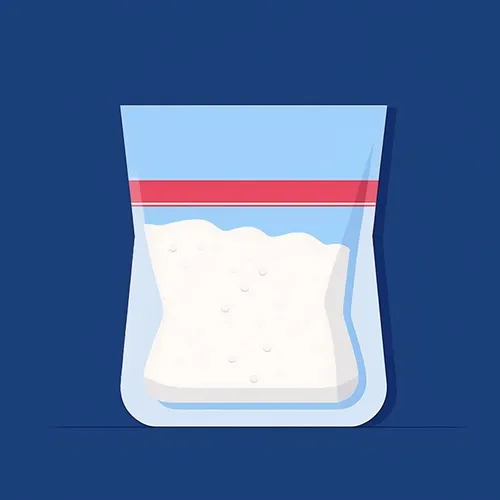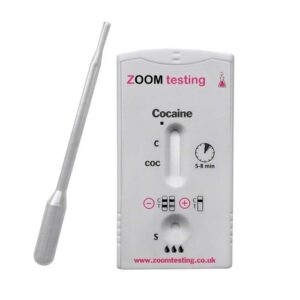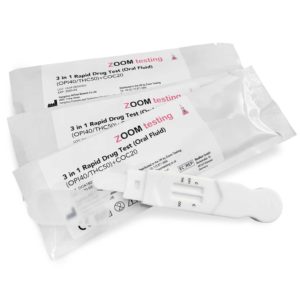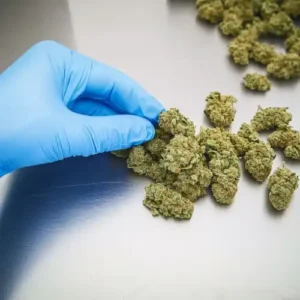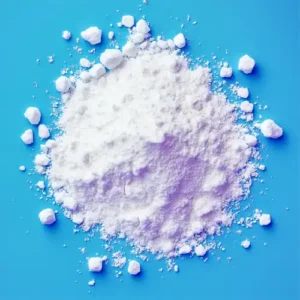There are various types of cocaine drug testing kits. In this article we explore the pros and cons of the various tests that you can buy from UK drug testing companies.
Even if you only use cocaine once, traces can remain in your system for as long as 90 days, depending on the type of testing being employed. The most commonly used method is urine testing, as is the least expensive. This particular testing method is used by everyone from schools and employers, all the way up the court system. Not only is urine testing relatively inexpensive, it also delivers results of recent cocaine use quickly and accurately.
Cocaine is often viewed as the drug of choice for the rich and famous, but its use is becoming more prevalent in all classes. In Britain alone, 2% of the population regularly use cocaine, which is about the same level as in the US.
Effects of Cocaine and Crack Cocaine
The dose and how quickly the cocaine enters the brain are what determines intensity.
When cocaine is snorted, it reaches the brain in about 3-5 minutes. Intravenously injecting the substance cuts that time down to between 15 and 30 seconds, whereas smoking delivers an experience that is almost immediate. The trade-off comes in the length of the high, with faster absorption leading to a shorter high time. For example, smoking delivers a 5-10 minute high, while snorting will keep a user high for 15-30 minutes. The after effects of the high is known as a “coke crash” and can include symptoms such as tiredness, irritability and depression. Frequent doses need to be taken if withdrawal is to be avoided.
Paranoia is a common side effect that comes with long-term use of cocaine at a high dosage. When smoking crack cocaine, that paranoia can quickly turn aggressive. Depression is common among addicted cocaine users who kick the habit. The mucous membrane of the nose can become negatively affected with prolonged snorting.
The Psychological Impact of Cocaine Use
Cocaine doesn’t just affect the body—it rewires your brain’s reward system. Each use can create powerful psychological dependencies that extend far beyond the immediate high. Users often experience intense cravings that override rational thinking, making addiction a complex psychological battle. The drug’s impact on dopamine levels can fundamentally alter mood regulation, leading to significant mental health challenges. What might start as occasional recreational use can quickly transform into a destructive cycle of psychological and physiological dependence, trapping individuals in a dangerous pattern that’s incredibly difficult to break.
Paranoia is a common side effect that comes with long-term use of cocaine at a high dosage. When smoking crack cocaine, that paranoia can quickly turn aggressive. Depression is common among addicted cocaine users who kick the habit. The mucous membrane of the nose can become negatively affected with prolonged snorting.
The History of Cocaine
Cocaine is a stimulant drug derived from the coca plant native to South America. Indigenous peoples in the Andean region have chewed coca leaves for centuries for their mild stimulant effects.
Pure cocaine was first isolated in the mid-19th century. In 1859, German chemist Albert Niemann isolated cocaine from coca leaves. In the late 19th century, cocaine emerged as a popular ingredient in tonics, elixirs, wines, and “medicines” touted to cure a variety of ailments. Famous psychoanalyst Sigmund Freud praised cocaine for its perceived benefits and even wrote a paper called “Über Coca” in 1884.
The addictive nature of cocaine soon became apparent. In the early 20th century, many Western countries banned the sale of products containing cocaine. However, cocaine remained popular as an illicit recreational drug through the 1970s. Usage declined in the 1980s as the harmful effects of the drug became more widely known.
The Rise of Crack Cocaine
In the 1970s and 1980s, a smokable form of cocaine emerged called “crack” or “rock” cocaine. Crack offered a faster, more intense high than snorting powdered cocaine. However, the effects of smoking crack only last 5-10 minutes, leading to compulsive re-dosing and addiction.
Crack cocaine wreaked havoc in cities across the United States in the 1980s and 1990s. The crack epidemic hit poor, predominantly African American urban neighborhoods the hardest. At the peak of the crack epidemic in the late 1980s, over 1 million Americans were addicted to crack cocaine.
In 1986, the US Congress passed the Anti-Drug Abuse Act, which instituted harsh mandatory minimum sentences for crack possession and dealing. Critics argued the crack sentencing disparity unfairly targeted African Americans. The Fair Sentencing Act of 2010 reduced the sentencing disparity between crack and powder cocaine possession from 100:1 to 18:1.
Health Effects of Cocaine
Cocaine is an extremely addictive substance that can cause both short-term and long-term health effects:
Short-term effects:
- Euphoria, extreme energy and hyper-stimulation
- Increased heart rate, body temperature and blood pressure
- Reduced appetite and sleep
- Paranoia, erratic behaviour, aggression
- Heart attacks, strokes, seizures
Long-term effects:
- Loss of sense of smell, nosebleeds, nasal damage from snorting
- Weight loss, malnutrition
- Liver, kidney, lung damage
- Increased risk of contracting HIV/AIDS and other diseases from needle sharing
- Auditory and tactile hallucinations
- Sexual dysfunction, reproductive damage
- Movement disorders, difficulty walking
- Alzheimer’s-like cognitive impairment
Cocaine Drug Testing
Testing for cocaine drug use is usually done in one of three ways: urine, saliva and hair. Using those methods cocaine can be detected for a period of 1, 4-5 and 90 days, respectively.
Cocaine Drug Testing: Urine Method
- The most affordable of all the methods
- An intrusive testing method
- Tests can be administered at home
- Cocaine detection for up to a week, or longer depending on how often the individual has been using
- A negative result can be delivered if the user abstains from taking cocaine for an extended period of time
- Urine Drug Tests for Cocaine are available as a Single Drug Test For Cocaine and Multi-Parameter Drug Tests including cocaine.
Here is a step-by-step guide to administering and reading a urine cocaine drug test:
Urine Drug Testing for Cocaine
Urine drug testing is the most common method for detecting cocaine use. Cocaine metabolites can be detected in urine for 1-3 days after last use for most users. Heavy users may have cocaine metabolites detectable in urine for 7-10 days or longer.
Urine cocaine tests work by detecting the cocaine metabolites benzoylecgonine and ecgonine methyl ester. Most urine drug tests have a cutoff level of 300 ng/mL for a positive cocaine test. This means a urine sample must contain at least 300 nanograms per milliliter of benzoylecgonine and/or ecgonine methyl ester to test positive for cocaine.
Urine cocaine tests are inexpensive. They are also easy to administer and have a rapid turnaround time, with results available within 5 minutes. However, urine tests can only detect recent cocaine use, not long-term or historical use. Urine is also easy to adulterate or substitute to produce false negatives.
To perform a urine cocaine test:
- The test subject provides a fresh urine sample into a clean specimen cup, minimum 45mL.
- Using the provided dropper, the tester transfers urine from the specimen cup into the sample well on the test cassette. Enough urine (2-3 drops) must be transferred to contact the reagent strip inside the well.
- The tester waits 5 minutes as the urine travels up the reagent strip inside the cassette.
- At the end of 5 minutes, the tester checks the indication window next to the “C” (cocaine) line.
- One red line means negative for cocaine. The test line did not detect cocaine metabolites above 300 ng/mL.
- Two red lines means positive for cocaine. Both the control line and test line are visible, indicating cocaine metabolite levels exceeded 300 ng/mL.
- No lines, or a test line without a control line, means the test is invalid and should be re-run with a new cassette.
Proper interpretation of the urine cocaine test results requires training and an understanding of the testing limitations. False positive results, though rare, can occur due to cross-reactivity or sample contamination. Other substances in the urine can also affect test performance. Valid negative results require the subject to abstain from cocaine use for at least 1-3 days before testing.
Cocaine Drug Testing: Saliva Method
Saliva drug testing is an emerging method to detect recent cocaine use. Cocaine and its metabolites can be detected in saliva for 12-48 hours after last use. Saliva testing is better at detecting very recent cocaine use compared to urine testing.
Cocaine saliva tests work by detecting the presence of the parent drug itself, not metabolites as in urine tests. Most saliva cocaine tests have a cutoff level of 20-50 ng/mL. This means a saliva sample must contain at least 20-50 nanograms per milliliter of cocaine for a positive test result.
Saliva cocaine tests are more expensive than urine tests. However, saliva collection is considered less invasive than urine. Saliva tests also have a rapid turnaround time with results in 5-10 minutes. But saliva is easy to adulterate to produce false negatives.
To perform a saliva cocaine test:
- The test subject rinses mouth with water 10 minutes before test. No food or other objects should be in mouth.
- The tester or subject gently rubs the collection pad on the inside of the cheek and under the tongue to collect saliva. Enough saliva is needed to activate the indicators on the collection pad.
- The collection pad is inserted into the test cassette. The tester times 5 minutes.
- At 5 minutes, the tester checks the indication window next to the “C” (cocaine) line.
- One red line means negative for cocaine. Cocaine was not detected above the cutoff.
- Two red lines means positive for cocaine. Cocaine exceeded the cutoff level.
- No lines or a test line without a control line means an invalid result.
Proper saliva collection technique is important to get an adequate sample. Food, blood, or other contaminants can affect results. Saliva cocaine tests are qualitative, giving a positive or negative result only. Quantitative confirmation requires laboratory analysis.
- Slightly more expensive than urine testing, but less than other methods such as hair and blood
- Considered to be one of the more non-intrusive testing methods
- Testing method becoming more prevalent
- Detects cocaine use during the past few days
- Is better at detecting recent use than other methods
- Perhaps not the best method when trying to make a legal case. This is due to the fact that no nationally accepted standards exist, nor a cut-off concentration for detection, which often mean results will be dependent upon the specific product used.
- Normally a Saliva Drug Test for Cocaine is part of a Multi-Parameter Saliva Drug Test such as a 3 Drug Oral Fluid Test or a 7 Drug Oral Fluid Test
Cocaine Drug Testing: Hair Method
- Far and away the most expensive testing method
- One of the most non-intrusive testing methods
- Able to detect traces of cocaine over longer periods
- Use within the past week is not usually detected
- The amount of hair required for testing needs to be about 1.5 inches long and pencil diameter. Can be done using a single strand
- Brief breaks from cocaine use will not affect the results
Photo: “Cocaine Bag” by Anthony Cunningham for Zoom Testing
Zoom Testing is a leading UK drug testing company and a supplier of Drug Test Kits.
This post was originally published in 2015. It was last updated in December 2024.

